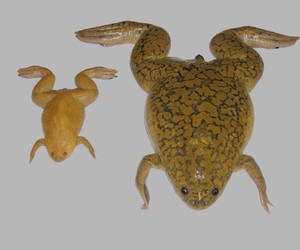An analysis of the genome of the Western Clawed Frog, Xenopus tropicalis was published in the journal Science this week, marking the very first amphibian genome sequenced.
Uffe Hellsten and colleagues at the Department of Energy Joint Genome Institute in Walnut Creek, report the finding that nearly 80% of genes associated with human diseases have their counterpart in the frog's genome - which has roughly the same number of protein coding genes as our own.

Image © Science/AAAS (c) Science/AAAS">The western clawed frog is particularly interesting for a number of reasons. Firstly, being the first amphibian to be sequenced it helps us to understand the full range of vertebrate genes - we've already got the rat, chicken, zebra fish and human genome, so we're filling a gap in the vertebrate family tree.
Also, the world's amphibians are under threat at the moment, with populations in serious decline. This genome may help to understand some of the problems that amphibians currently face, and so give us clues as to how to prevent further losses.
But the western clawed frog is more than just an example the class Amphibia - it's of particular interest to us because it's biologically similar to it's cousin, the African clawed frog or Xenopus laevis. The African clawed frog has been vital to our understanding of embryology since it was used for pregnancy testing back in the 40s. It has large, sturdy and easily manipulated eggs, and so it, and it's smaller relative the western clawed frog, rapidly became some of the most popular organisms in embryology.
The frog's genome is remarkably similar to that of the chicken or our own in basic structure, for example, frog genes have very similar neighbours compare with human genes about 90% of the time. We last shared a common ancestor with frogs around 360 million years ago, but there are around 1700 genes in the frog genome that are very similar to disease-related human genes.
Frogs are known to produce their own antibiotic compounds, to help keep their moist skin free from infection, and some of the genes responsible for this have already been identified.
The researchers were surprised to see a very large proportion of mobile genetic elements, called transposons - accounting for about one third of the genome. These generally don't code for a protein, but are involved in controlling the way the genes work, including reorganising genes in the chromosomes. It will take more research to discover the real implications of this.
This discovery will create new ways to look at human development and disease, as well as act as a scaffolding for sequencing the larger X. laevis genome. It will also help in the process of chromosomal archaeology - allowing us to piece together the story of vertebrate chromosomes, and how they developed into the incredible variety of species we see today.










Comments
Add a comment